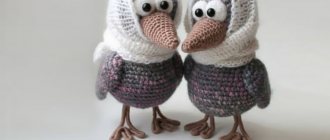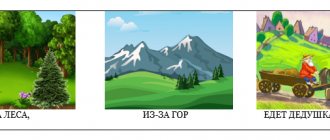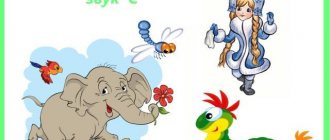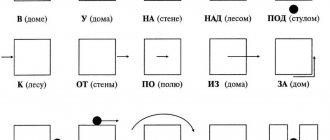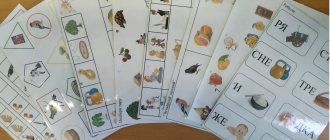Pure sayings starting with the letter Sh
Sha-sha-sha-sha, our Tanya is good.
Sho-sho-sho-sho, he sings well. Shu-shu-shu-shu, - sings a song to the baby. Shi-shi-shi-shi, kids love songs. Sha-sha-sha - we love the baby. Sha-sha-sha - the mother washes the baby. Sha-sha-sha - I’m sitting by the hut. Shu-shu-shu - I'm writing a letter. Ash - ash-ash - Marina has a pencil. Shoo-shoo-shoo—the mouse jokes with the cat. Ysh-ysh-ysh - the cat is afraid of the mouse. Ysh-ysh-ysh - a mouse rustles under the bench. Shey-shey-shey - I'm afraid of mice. Oshka-oshka-oshka - the mouse catches the cat. Eat, eat, eat, and you’ll get yourself a bump. Ear-ear is my pillow. Ear-ear is a soft pillow. Ear-ear - I put a pillow on the bed. Ear-ear - I'll sleep on the pillow.
Sixteen mice walked, And six carried pennies; And the mice, which are worse, Noisily scrounge for pennies.
Forty mice walked, carrying forty pennies. Two mice, which were worse, carried two pennies each.
A mouse squeaked among the reeds: “Your rustling broke the silence!” The reeds whisper noisily: “Hush, mouse, don’t rustle!” The cat will hear your rustling, You should go to your grandmother, baby, if you disobey us, mouse, - The cat will snatch you, silly! In general, mouse, don’t make a noise, it’s better to hurry into the hole. The mouse did not listen to them, The baby squealed again: - For me, fearless, a cat is like a midge for the same cat... Since then, the mouse has not been heard, the playful braggart Vladimir Kremnev.
Teenager
In children over 14 years old, sound automation begins with independent composing of syllables, reading them, highlighting the problematic sound. First you need to pronounce combinations where Sh is in an open position: ash, ush, ish, ish, yush, esh. Then switch to syllables with a closed position: sha, shu, shi, she, she. From syllables they move on to reading words, first starting with the desired letter, then at the end and in the middle of the word:
- Jackal, noise, hut, rustle, whisper, chocolate, hornet, bumblebee, joke, chic, neck, tire, washer, silk, scow, sharpie, champignon, curtains, blinkers, husk, screen.
- Baby, brooch, mascara, breach, quiet, good, lie (w), rye (w), luggage (w), garage (w).
- Noodles, jerboa, hawthorn, pot, arshin, fur, crumb, basket, matryoshka, grandfather, powder, drying, brooch, nightmare, cannon, frog.
Next, the words are used to form phrases. You can invite the teenager to combine the words themselves, or read ready-made examples:
- Wide pot.
- Big cup.
- Good powder.
- The best brooch.
- Big frog.
- Jerboa jumps.
With a teenager, you can perform exercises that involve selecting words that are opposite in meaning or synonyms, and composing phrases:
- I'm walking along the highway.
- The big frog went into the forest.
- Wash a good pot with powder.
- He has a big scarf.
- He is embroidering a scarf.
- I wear a hat with earflaps and a fur coat.
You can use tongue twisters, proverbs, and sayings. It is important not just to pronounce, but also to work on intonation: speak loudly, clearly, quietly, slowly, drawn out, quickly, accelerate, highlight the desired sound.
| Proverbs | Even a needle and thread interferes with sewing for an inept seamstress. Murder will out. You'll walk away from a drop, but you'll end up in the rain. |
| Tongue Twisters | The mouse whispers to the little mouse: -You keep making noise, making noise! The little mouse whispers to the mouse: -I'll be quieter. The cuckoo sews a hood for the cuckoo, The cuckoo will put on its hood. How funny he is in the hood! |
| Sayings | You are welcome to our hut. At the feast the beaters are dancing. The sooner you start, the sooner you get there. |
Working with texts for teenagers is an integral part. Using them, you can check how automated the sound in speech is. The work is carried out using several methods:
- reading text highlighting the desired sound;
- retelling the text;
- search in the text for words with the letter Ш, reading;
- composing a text with a variety of words starting with the desired letter.
An important part is retelling and composing, as it allows you to test natural speaking. When a child reads a text, sees a problematic letter in advance and concentrates his attention on it, he tries to read it correctly. When retelling or composing a text, speech is not controlled by the teenager, especially if the words are pronounced without interruption or pauses.
Automation of the sound Ш in words
1. In the silence of the night, the rustling of a snake is barely audible near the reeds. 2. Masha has whey in her porridge. 3. Mom gave Romasha whey from yogurt. 4. Glasha was given curdled milk, and Glasha had porridge. 5. They gave curdled milk to Klasha. Klasha is dissatisfied: “I don’t want yogurt, just give me porridge.” 6. There are six naughty girls in the hut. 7. Sasha knocked over some bumps with his hat. 8. On the window, the cat deftly catches a tiny midge with its paw. 9. The slippery cones rustled and splashed noisily from the pine tree. A layer of snow, like a shawl, will hide the cones until spring. 10. Sasha sewed a hat for Sasha. 11. A hat and a fur coat - that’s all Mishutka is. 12. Mishka knocked down the pine cones with his hat. 13. Donuts and shanezhki - for Pashka and Sanechka. 14. Six little mice rustle in the reeds. 15. Forty mice walked, carrying forty pennies; two smaller mice carried two pennies each. 16. Sixteen mice walked and six found pennies. 17. The mouse whispers to the mouse: “You keep rustling, you’re not sleeping.” The mouse whispers to the mouse: “I will rustle more quietly.” 13. Spy and spy - millet. 14. A car was walking down the street, a car was walking without gasoline, a car was walking without an engine, a car was walking without a driver, a car was walking without knowing it, a car was walking... winding. 15. Gleb walked with bread, Olya walked with salt. 16. Proshka made a mistake with the bowl - Proshka turned the bowl over. 17. Our conscience is a sail, even a storm will not frighten us. 18. Frol walked along the highway to Sasha to play checkers. 19. Cones on the pine tree, checkers on the table. 20. Maybe grandma knits, but ask - she won’t tell (f, s, w). 21. Vanechka - Vanyushka, Tanechka - Tanyushka, Katechka - Katyushka, Nadechka - Nadyushka, Vitechka - Vityushka (h, w). 22. Pasha hid all the toys under the pillow. It’s stuffy with toys hidden under the pillow. 23. The seamstress sews pants for Masha, Pasha, Dasha and Natasha. 24. Cats breathe, mice breathe, bears and kids breathe. 25. Grandma Lusha was going to see baby Grusha. Lusha has big pears in her basket. 26. Grisha covers the roof for Gosha, Alyosha and Misha. 27. There are noodles on the sleepers. 28. Your spy will not out-spy our spy, but our spy will out-spy your spy. 29. Antoshka has a little porridge in his spoon, and Timoshka has a little potato in his spoon. 30. Timoshka Troshke crumbles crumbs into okroshka. 31. Timoshka’s mongrel barked at Pashka. Pashka hits Timoshka's mongrel with his hat. 32. Although the pike is eager, it will not eat the ruff from its tail. A ruff is good for a ruff. (fishing equipment made of rods in the form of a bottle, funnel). 33. Old talkative women live in a hut at the edge of the forest. Every old lady has a basket. There's a cat in every basket. Cats in baskets sew boots for old women. 34. The old woman listened to the cuckoo crowing at the edge of the forest. 35. Masha stirs the porridge, and Misha interferes with Masha. 36. Masha has midges in her porridge. What should our Masha do? I put the porridge in a bowl and fed it to the cat (S. Pogorelovsky).
Rules for successful automation
When automating sound, the correct placement of the speech apparatus plays an important role. Sometimes children forget after classes with a speech therapist how the tongue and lips work when pronouncing a problem sound. Before each lesson, you need to pronounce the correct position. The work should be carried out before exercises with syllables.
Where to start
A child and an adult must understand where the tongue is, how the teeth and lips are located. This is not easy to understand when there is no professional assistant nearby. When pronouncing the sound Ш, the lips move forward, the teeth should be partially closed. The tongue is extended forward, the tip rises to the sky without touching it. The sides of the organ should be in contact with the molars. The vocal cords are not involved in pronunciation, there is no voice.
When automating at home, you need to talk to your child about correct articulation before completing tasks:
- stretch your lips forward, imagine that it is a pipe or tube;
- stretch your tongue forward towards your teeth, lift the tip up, feel the palate;
- lower your tongue a little so that it does not touch the palate, form a gap between them;
- imagine that the tongue is a cup from which the cat will lap milk, you need to prevent it from spilling, make it deep (you need to show that the edges of the organ should touch the molars);
- try to make a sound without using your voice, as if a snake is hissing.
Parents begin work on sound automation, making sure that the child has correct articulation and can repeat it several times without gross violations.
Articulation warm-up
For successful automation, each lesson should begin with an articulatory warm-up. It allows you to warm up the muscles of the speech apparatus. It is necessary for children and adults to carry it out. To prepare the articulatory apparatus, classical exercises are used aimed at honing the pronunciation of the sound Ш: shovel, painter, pie.
Shovel
The exercise helps overcome muscle tone by relaxing the organs of articulation. You need to stick your tongue forward, it may be tense at first. Afterwards, children are asked to smile, but without straining their lips. The end of the tongue rests on the lower lip, the sides easily touching the corners of the mouth. You need to achieve relaxation of the organ; you should hold in this position for several seconds. In subsequent times, you can increase the relaxation time to train the muscles. Exercise “Shovel” is a basic exercise for correcting hissing sounds.
Painter
Children are asked to imagine themselves as a painter who needs to paint the roof of their mouth. To do this, you should open your mouth slightly in a slight smile, without straining your lips. The jaw should not move. The exercise is complex and involves “painting” the upper part of the mouth with the tongue from the pharynx to the teeth and back. Important: the child must keep his tongue in constant tension, control it so that it does not come out. The task allows the baby to understand how and where to point the tongue when making the sound Ш.
Pie
The exercise is often used in speech therapy, is complex, and trains the lateral muscles of the tongue. Don't be upset if your child doesn't complete the task the first time. Not every adult will be able to repeat the movements of a speech therapist. In children with regular practice, success comes on the 5-7th day.
You need to relax your tongue, as in the “Shovel” exercise, so that it lies calmly on your lower lip. Then ask the baby, without straining the organ, to try to bend its side parts inward, forming a funnel. As a result, the baby should see a funny “pie” made of tongue in the mirror. You need to hold this position for 5-10 seconds.
It is necessary to train not only the organs of the articulatory apparatus before automation, but also correct breathing.
Speech therapists recommend using soap bubbles, tubes, whistles, paper snowflakes or cotton balls that need to be blown away to develop breathing in children. You can play with your preschooler on his birthday, blow out the candles on the cake or pie that mom prepared for the doll. An adult can inflate balloons.
Recommendations
Consolidating the correct pronunciation of sounds in speech is called automation. The process should not be taken lightly. It is important to move to this stage only after regular articulation gymnastics, when the baby begins to make progress in correct articulation and positioning. Automation of the sound Ш occurs in words, sentences, and text. You always need to start with the easy ones and gradually move on to the complex ones: from syllable to word, from sentence to text.
Automation of the sound Ш in words implies compliance with the rules:
- It is impossible, if there are problems with several consonant letters, to automate all at once those that a person confuses in speech: Ш, С, Ш, Ж, З, etc.;
- you need to move on to fixing the sound after a person learns to pronounce it autonomously several times in a row;
- in the process of automation, the child needs to use visual material to make it interesting to learn (cards, coloring books, cubes, etc.);
- Before doing exercises and reading, always warm up the articulatory muscles with the help of gymnastics;
- when automating, adhere to the rule - act from simple to complex;
- You need to practice every day, without burdening the child or adult (preschooler - 15 minutes, schoolchild - 20-25 minutes, adult - 30-40).
Automation of sound is a complex but interesting process. The result and the duration of the correction will depend on the reason for the incorrect pronunciation. You need to approach each individual case individually. If parents cannot correct their pronunciation over a long period of time, they need the help of a speech therapist. Perhaps the cause of the problem is the peculiarity of the structure of the speech apparatus, then, along with speech therapy classes, the help of doctors will be needed.
Adult
Automation of sound in adults is needed not only because of speech therapy disorders. Often, pronunciation problems arise after cardiovascular disease (for example, if a person has suffered a stroke). The process of automation in an adult is very similar to that of a teenager. According to the rules of speech therapy, work is carried out with syllables, words, phrases, sentences, and text. The exercises should include complex tongue twisters and pure tongue twisters.
An adult is asked to read syllables and simple words. You can call opposite in meaning synonyms. It is important to first read words starting with the letter Ш, secondly those ending with Ш, and then move on to words with the letter Ш in the middle.
An adult can move from reading words to sentences. It is important to pronounce the desired sound in each word, speed up or slow down the pace of reading:
- Masha eats chocolate.
- Mice rustle in the hut.
- Grandmother eats hawthorn.
- Pasha found some waves at the edge of the forest.
- Alyonushka consoles the baby.
Complex tongue twisters help automate sound. It is worth moving on to them after the adult has managed to achieve correct pronunciation of words and phrases.
Here are the kids Masha, Misha. Masha is smaller, Misha is taller. Misha is writing something to Masha. Guess what Misha writes.
The hedgehog washed his ears, neck, and skin on his belly in the bathhouse. And the hedgehog said to the raccoon: “Will you rub my back?”
After tongue twisters, they move on to reading texts and retellings. You can take children's stories aimed at articulating and automating the sound Sh.


